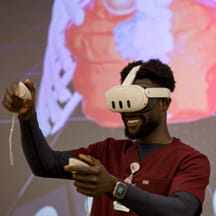Part 1: Diagnosis
At 18 months old, Dalton started waking up in the night gasping and screaming. Six months later, he suddenly lost his hearing and his speech. Then he began faltering — and falling.
His mom Kara knew something was terribly wrong.
“I told my kids we were going to lose him,” she said.
She was right. Dalton's nervous system was breaking down. Damage to cranial and spinal nerves had already made him deaf and palsied. Without treatment, his optic nerves would soon fail and make him blind. Neurons would go out like blown lights. He’d start seizing. He’d stop moving. Eventually, his lungs would fail, and he’d suffocate.
For six months, Kara had gone from doctor to doctor searching for answers. Local providers told Kara there was nothing to worry about. Others tried for a diagnosis but came up short.
If she hadn’t decided to drive her 3-year-old nearly 200 miles to Children’s Mercy Kansas City, she would have lost Dalton.
Instead, his deterioration stopped. He can hear his siblings’ voices. He can climb into everything his mom tells him to stay out of.
“He doesn’t let anything stop him, that’s for sure,” she said.
For families facing rare diseases, tortuous diagnostic odysseys are the norm. Two-thirds of children with a rare disease never receive a diagnosis, and for those fortunate enough to find an answer, it takes an average of five years.
But over the past decade, genome sequencing has provided promising maps of these mysteries. More than 80% of rare diseases are caused by genetic mutations — basically typos in the DNA. Being able to read a child's genome allows scientists to identify the genetic misspelling, like a proofreader scouring a tome.
“The only way to get to the ultimate diagnosis of these kids is finding any one of those 1000s of genes that we know are linked to rare disease to be altered in a way that you never see in healthy children,” said Tomi Pastinen, MD, PhD, vice president and associate chief medical officer for clinical and research integration at Children’s Mercy.
Genome sequencing is what enabled the Children’s Mercy team to diagnose Dalton with Brown Violetto Bandlier Syndrome, a neurological disorder leading to a progressive decline in the nervous system. It’s how they knew to treat him with vitamin B12 to keep him from deteriorating. It’s why Kara can now tell her kids they’re not going to lose their little brother.
And it’s only the beginning.
Because of recent advancements, Children’s Mercy can now do what they did for Dalton more effectively and quickly than ever before.
“The hope is that when any physician anywhere suspects a genetic disease, we order a comprehensive test as early as possible and deliver that as quickly as possible,” Pastinen said. “That leaves the greatest window of opportunity for intervening.”
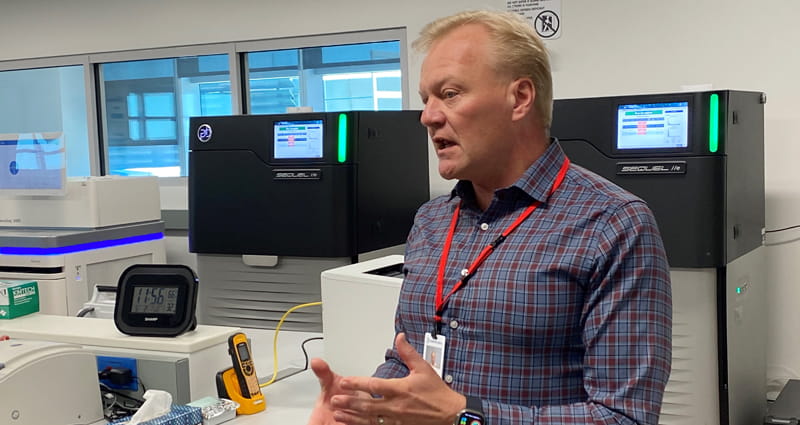
The promise of pediatric genomic medicine
For about a decade, researchers have been able to sequence children’s genomes. But the typical way of sequencing, called “short-read,” only looks at small fragments of DNA.
Even the most advanced versions examine just 2%, leaving vast blind spots. Many conditions, including complex movement and muscular disorders like infant hypotonia, ataxias, and dystonias, slip through unnoticed. This is why only one-third of all kids with a rare disease find a diagnosis.
A newer way of sequencing, called “long-read,” looks at 100% of the genome, leaving no stone unturned. And although the sequence is longer, the process is faster.
Where physicians once ordered up to five separate tests to hunt for variants, long-read sequencing now captures everything in one run. What once stretched across months or years now unfolds in less than two weeks.
“Long-read sequencing increases the overall diagnostic yield of patients so we can do it quicker and more thoroughly, and we can increase the number of patients that get answers,” Pastinen said.
For patients like Dalton, the time to diagnosis is the difference between life and death. Around 30% of children with a rare disease die before they turn 5. For other children, it determines whether they can walk or talk, whether they can see or hear. Once some diseases progress, the damage can’t be undone.
A couple years ago, Children’s Mercy became one of the only hospitals in the world to use long-read sequencing, which is why they had an answer for Dalton and how they will have an answer for untold numbers of kids who would otherwise be left with none.
“The long-read genome sequencing we pioneered here in the last five years is a single-stop shop for molecular diagnosis of children,” Pastinen said. “And it’s already bearing fruit in the clinical care of children.”
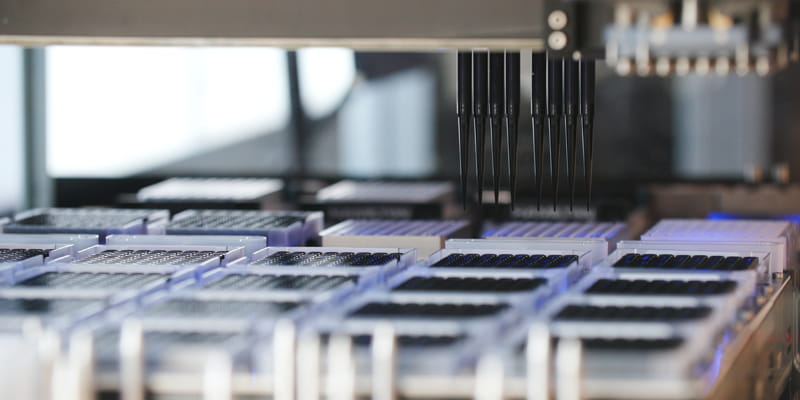
The single-stop shop — Children’s Mercy’s Genomic Medicine Center — has made more than 2,200 rare-disease diagnoses, collected data from over 17,000 participants, and built a pediatric genome repository of more than 30,000 sequences.
And they’ve made all their data and discoveries available to everyone.
Under controlled NIH mechanisms, the hospital shares de-identified data with research partners worldwide, and through a cloud-based platform any clinician can match their patients’ genetic profiles against Children's Mercy’s genome repository.
“It’s not just about one child’s diagnosis,” said Pastinen. “It’s about advancing knowledge so that the next child doesn’t have to wait."
Part 2: Clinical Treatment
At the hospital’s Genomic Medicine Center, Scott Younger peers into a petri dish studying the brain of a 3-year-old boy named Callum. He watches as the brain flickers with neon luminescence. He’s on the verge of a discovery, using a method he’s been developing for half a decade.
Meanwhile, Callum is at home rolling on the floor with his 6-month-old sister, who he is absolutely enamored with. Though Callum is 100% dependent due to a rare genetic disorder, he loves to play and laugh with his sister in his own way, and he enjoys the feeling of water in a pool and the nuzzle of his dogs Clancy and Maeve and the whoosh of swinging on a playset.
But these moments, so full of light, are always covered in shadow — at any moment Callum may suddenly startle and cry and require an immediate trip to the ER. The seizures come in clusters, day and night, every day. Any can be catastrophic for Callum’s brain. All cause him pain.
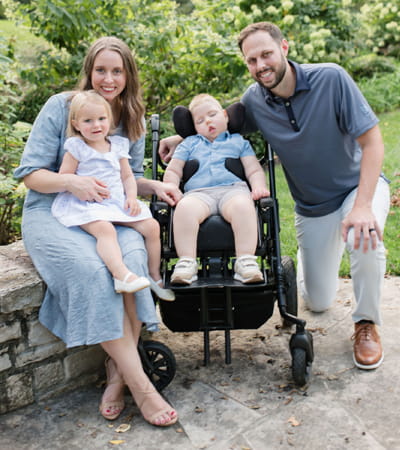
Center in Kansas City.
Even after hundreds of seizures, the experience never gets easier for his parents. Early on, his mom Mary would stare at Callum all day, waiting in terror for the next one. So many times she has pulled off to the side of a busy highway to attend to him. So many times she’s set out on an errand that ended in hospitalization. Never have she and her husband Logan both been able to leave his side.
So mostly the family stays home except when they go to the hospital, where they spend about as much time as they do at home. If they do venture to a friend’s house or his grandparents or to church, they always note the closest hospital, always have their keys nearby.
They’ve lost track of how many medications he’s trialed, of how many remedies he’s tried — gut detoxes, supplements, house toxin removals, natural therapies, and every kind of diet. They’ve tried chiropractors and functional medicine practitioners. They’ve read everything they can find, talked to everyone who would listen.
They’ve sought out researchers in the United Kingdom and the Czech Republic and Spain and France.
“I feel like I’ve gone to the ends of the earth,” Mary says.
They don't realize their journey to the ends of the earth is about to end exactly where it started, in their hometown, in an unassuming American state sometimes referred to as “flyover country,” in a small plot of land that houses one of the most advanced pediatric genomic laboratories in the world.
They don’t realize that soon Callum’s seizures will drastically improve, that he will go to school and church and his grandparents regularly, like everyone else. That trips to the grocery store will no longer turn into trips to the hospital. That Mary and Logan will finally have a night out, a break from seeking and searching and praying.
This will all happen because back in the lab in the Genomic Medicine Center, Younger figured it out. He figured it out on a replica of Callum’s brain floating in a dish.
He found the one drug that will soothe Callum’s seizing — a drug that no one would ever have found or considered at all if it wasn’t for Younger’s precision medicine lab built exactly for a moment like this.
Miniature molecular marvels
Using stem cells derived from Callum’s blood, Younger, director of disease gene engineering, created a 3D cellular model of his brain called an organoid. It is the size of a letter on a penny and looks more like a bouncy ball than a contoured, wrinkly peanut. But it mimics the brain at the molecular level, with all its neuronal activity.
It acts just as Callum’s brain would act, so Younger can experiment on it as if it were Callum’s own brain.
A special green dye applied to the organoid reveals brain activity. In patients with healthy brains, the activity appears as blips of light. In the brains of patients with seizures, it looks like fireworks.
“It’s a dramatic difference. You see neuronal hyperactivity. It looks like a light show. They’re just going off everywhere,” Younger said.
By applying drugs to Callum’s brain organoid, he can see which ones will halt the hyperactivity and which won’t. The lab has the ability to test drug responses in up to 96 organoids in parallel, though with Callum they focused on just a handful of carefully selected drugs based on his clinical diagnosis.
The traditional process to find a treatment involves a child trying a single drug at different doses for several months, fingers crossed, before moving on to another one. Years may go by without an effective treatment. Sometimes, one is never found.
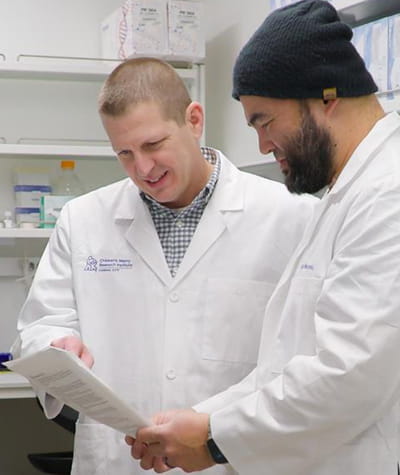
find treatments for rare diseases using organoids.
“There are more than 30 FDA-approved anti-epileptics. Only one, or a small subset, works for a given patient, and the clinician doesn’t know which one it’s going to be,” Younger said. “The process can take more than a decade.”
The Genomic Center’s process — from growing the organoid to testing it to validating the therapy — takes about seven weeks.
In Callum’s case, Younger’s test revealed one drug, and only one, that softened the lights in his brain. It was not an anti-epileptic at all but a treatment for hypertension. Because of its risks, it never would have been tested or tried if not for the Children’s Mercy Genomics Center.
“We had a theory that this could work, but we had no wherewithal to get this done,” Mary said after her long journey researching Callum’s condition. “Callum’s doctor said trying the drug could kill him. But Dr. Younger and Dr. Jean-Baptiste Le Pichon, his neurologist, made the dream come true for us.”
Though Callum still has issues from his disorder, his seizures are now barely noticeable. What used to happen all times of the day in quaking clusters are now mere flinches here and there.
“He’s the easier of my two kids now,” Mary said with a laugh. “I was terrified of leaving my house with him. Now, there’s nowhere he can’t go."
A new frontier
Callum is only one example of the Genomic Center’s remarkable ability to quickly find appropriate therapies for individual patients using organoids.
With heart organoids, they can measure contractions to test therapies on patients with heart arrythmias or muscular dystrophy. After its success modeling seizures in brain organoids, the lab is now exploring their use in additional neurodevelopmental conditions such as ADHD.
Younger and his team have built the infrastructure and methodology to do this consistently at scale, which is how work in the lab translates to the bedside of a patient in a matter of weeks.
“As a researcher, when we’re doing work in a lab, we often have this hope that we’re doing something that might change the world in the decades ahead. It just takes that long,” Younger said. “The fact that we can do an experiment and within a couple of months a patient’s life has been transformed is really exciting."
Younger hopes this kind of personalized, genetic-based method will one day be a standard part of care.
“We’re full steam ahead with building up a clinically facing platform where there’s just another blood draw, and then all of a sudden you have this blueprint of what a therapeutic treatment plan might look like, without having to think about it and no guesswork,” Younger said.
As with their database, the hospital has made their organoid process, which took years to hone, freely available to other hospitals in a recent paper published in Nature.
“We put in every detail and even added extra supplementary material. There are no proprietary steps,” Younger said. “We believe this type of work should be going on everywhere.”
